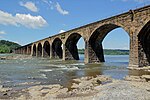Locust Grove (Bainbridge, Pennsylvania)
1782 establishments in PennsylvaniaHouses completed in 1782Houses in Lancaster County, PennsylvaniaHouses on the National Register of Historic Places in PennsylvaniaLancaster County, Pennsylvania Registered Historic Place stubs ... and 1 more
National Register of Historic Places in Lancaster County, Pennsylvania

Locust Grove, also known as the Haldeman Mansion, is a historic home located at Conoy Township in Lancaster County, Pennsylvania. It was built about 1782, and is a large, two-story, four-bay by two-bay stone dwelling overlooking the Susquehanna River. It has a massive central chimney Also on the property is a rectangular, two-story stone building with a hipped gable roof.It was listed on the National Register of Historic Places in 1977.
Excerpt from the Wikipedia article Locust Grove (Bainbridge, Pennsylvania) (License: CC BY-SA 3.0, Authors, Images).Locust Grove (Bainbridge, Pennsylvania)
Northwest Lancaster County River Trail,
Geographical coordinates (GPS) Address Nearby Places Show on map
Geographical coordinates (GPS)
| Latitude | Longitude |
|---|---|
| N 40.078888888889 ° | E -76.660555555556 ° |
Address
Haldeman Mansion
Northwest Lancaster County River Trail
17502
Pennsylvania, United States
Open on Google Maps









